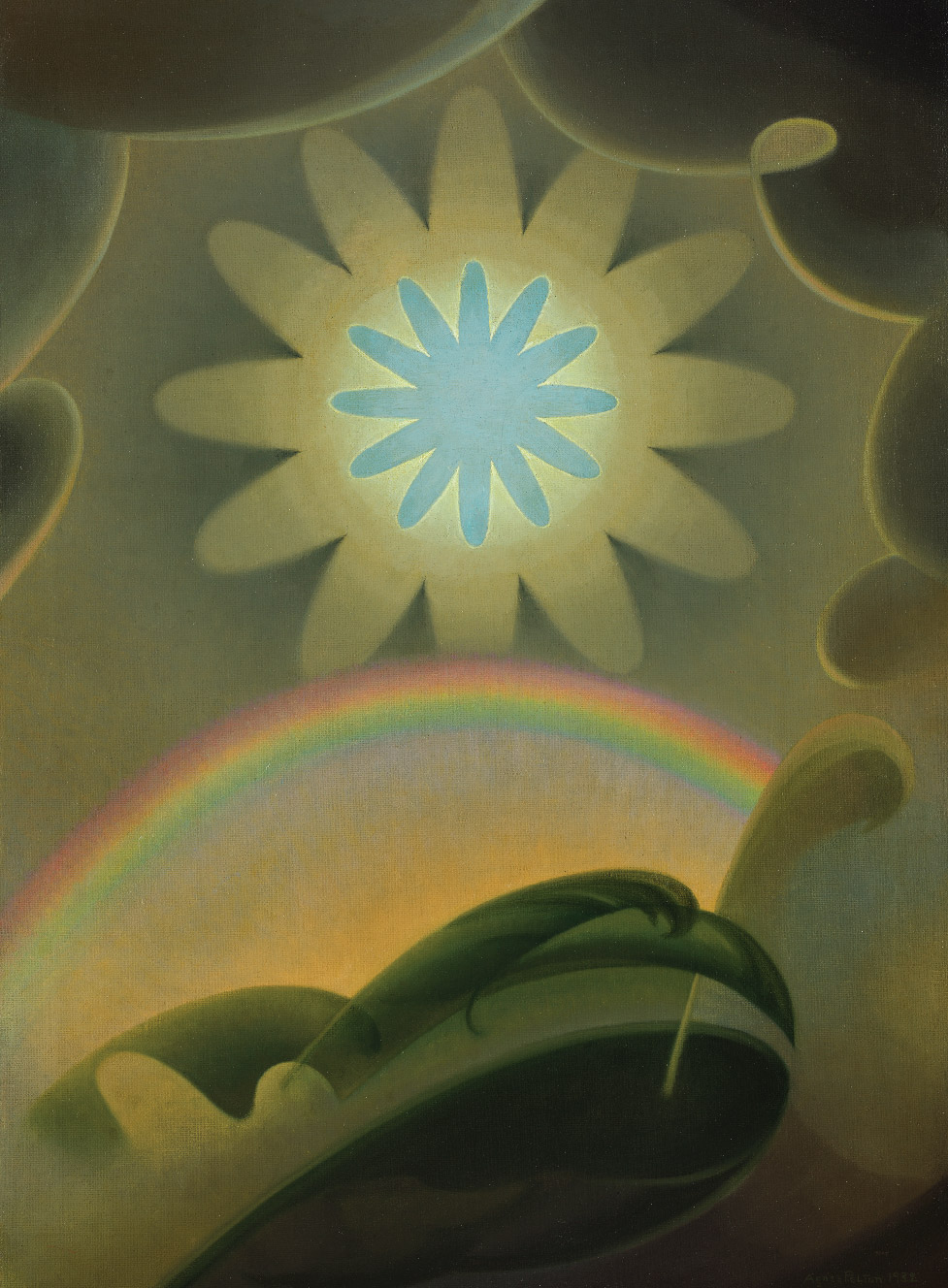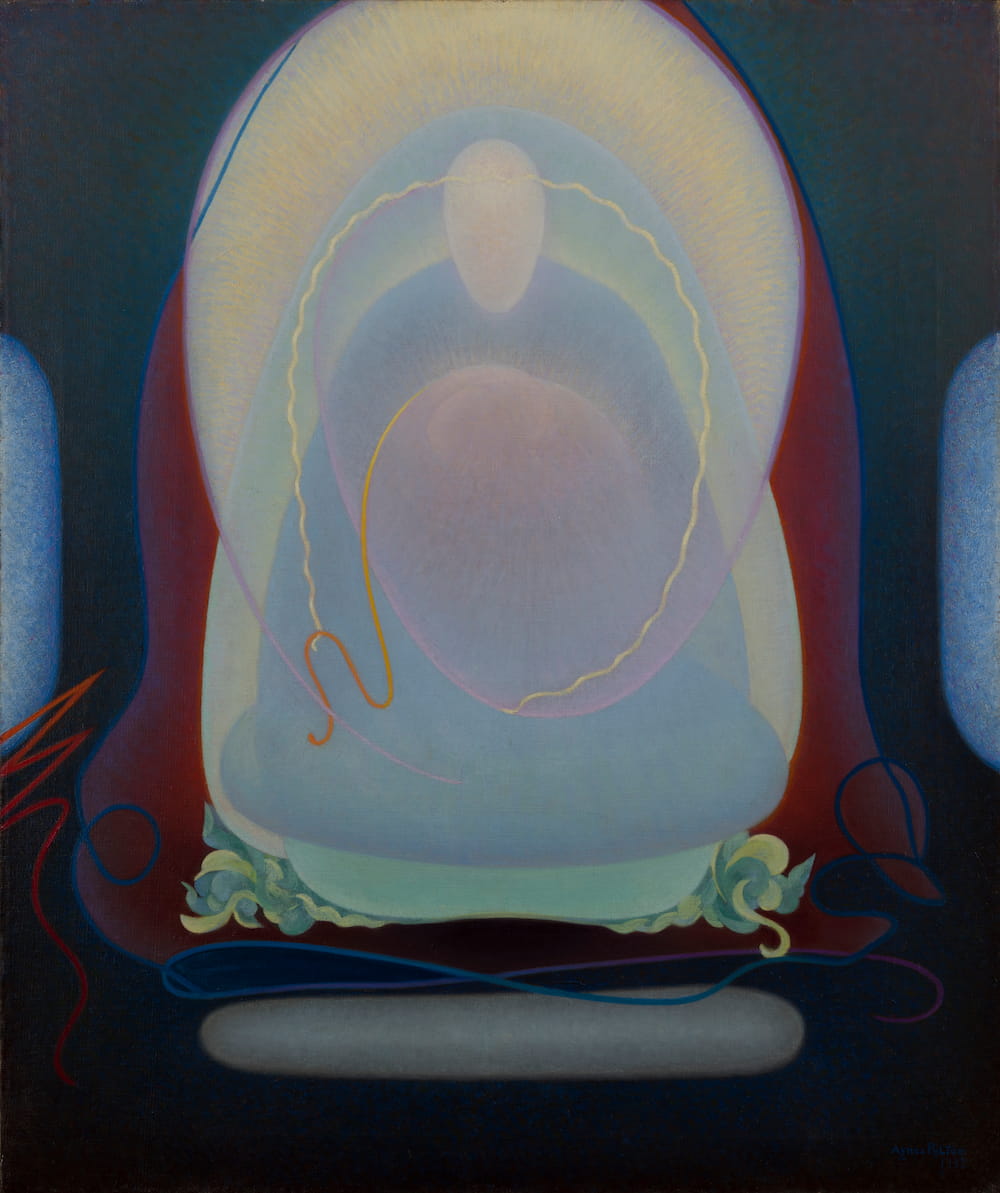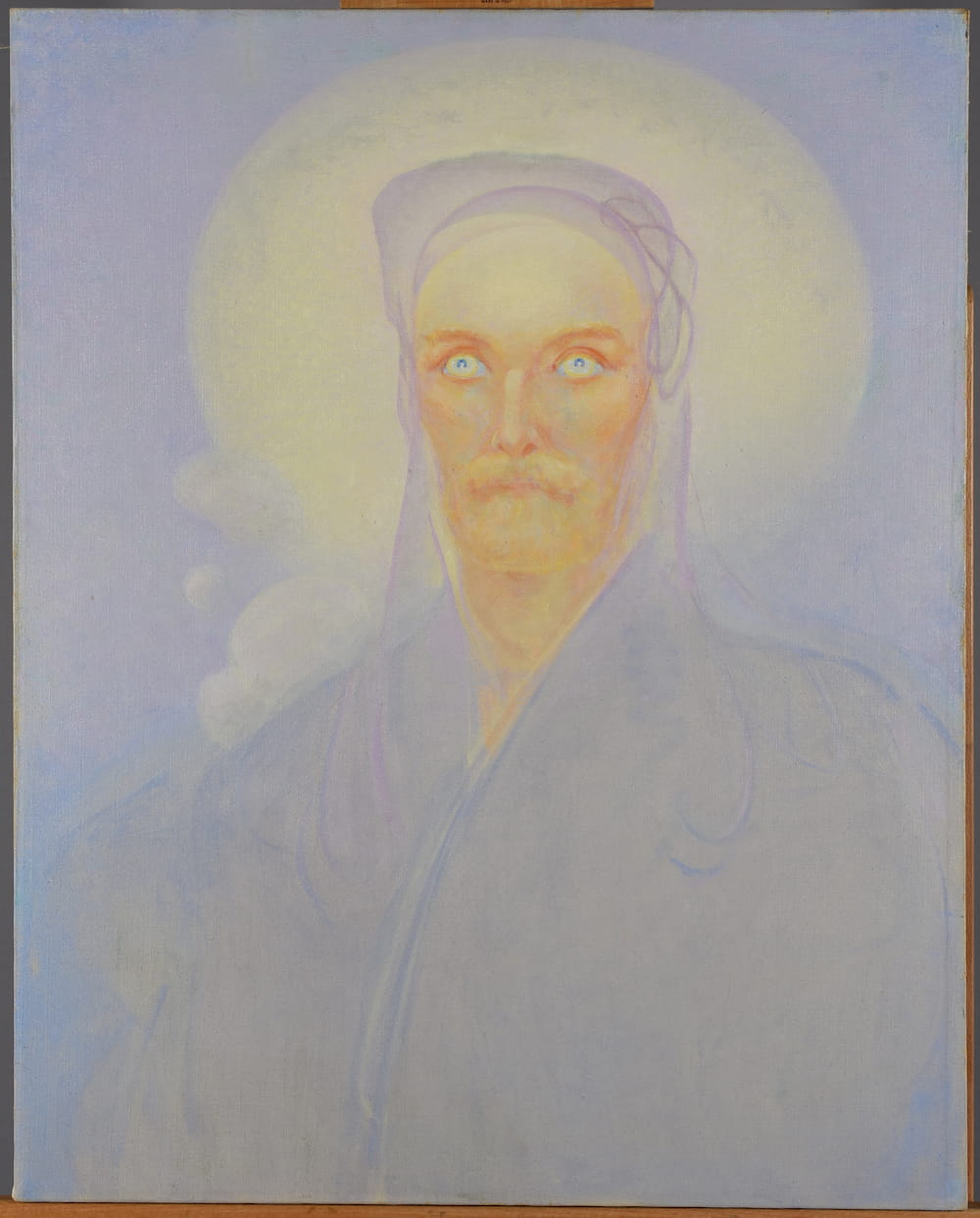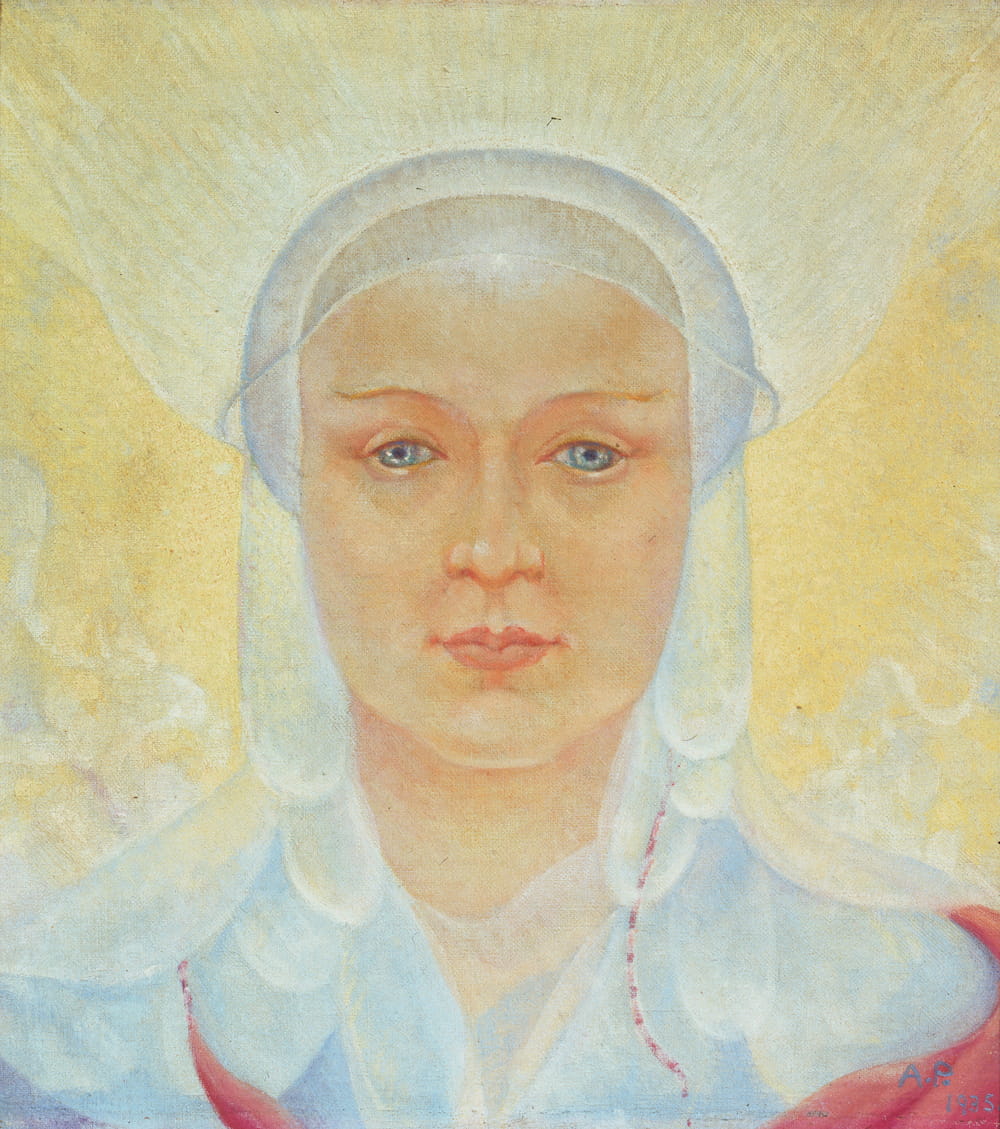Abstraction
Agnes Pelton: Desert Transcendentalist focuses on the artist’s abstract work that emerged in the 1920s. The Ray Serene (1925) is the earliest of these works. Inspired by the formal techniques of German Expressionism and perhaps Pelton’s subjective iteration of the synesthesia Kandinsky was so closely associated with, its composition is dominated by organic shapes and lines characterized by saw-toothed brush marks that define and contrast areas of surface and depth. Paintings such as Being (1926) and The Fountains (1926) become completely untethered from reality and move towards a surreal embodiment of light, space, and vibration that borders on science fiction.
Her first desert abstractions include Sand Storm (1932), Messengers (1932), and Orbits (1934), which reflect the trials and rewards of desert life. In Sand Storm, probably her first abstraction made after arriving in Cathedral City, she captured the moment when a blinding storm begins to wane and the parting clouds reveal a rainbow and emerging sun. Curator and art historian Michael Zakian writes that in Messengers an ethereal urn represents a well of heat as a nurturing force rising from the rocky desert floor. It is topped with palm fronds—perhaps a reference to the dwellings of the native Cahuilla people—and reinforces her belief that the desert is a comforting place to those who can tolerate the heat and grasp its beauty.
Agnes Pelton: Trascendentalista del desierto se enfoca en la obra abstracta de la artista que surgió en la década de 1920. El rayo sereno (1925), es la primera de estas obras. Inspirada en las técnicas formales del expresionismo alemán y quizás en la iteración subjetiva de la sinestesia con la que Kandinsky estaba asociado, la composición está dominada por formas y líneas orgánicas, caracterizadas por pinceladas serradas que definen y contrastan áreas de superficie y profundidad. Pinturas como Ser (1926) y Las fuentes (1926) se desvinculan completamente de la realidad y se mueven hacia una encarnación surrealista de luz, espacio y vibración que raya en ciencia ficción.
Sus primeras abstracciones en el desierto incluyen Tormenta de arena (1932), Mensajeros (1932) y Órbitas (1934), que reflejan las pruebas y las recompensas de la vida en el desierto. En Tormenta de arena, probablemente su primera abstracción realizada luego de su llegada a Cathedral City, capturó el momento en que una tormenta cegadora comienza a disminuir y las nubes que se disipan revelan un arco iris y un sol emergente. El curador e historiador de arte Michael Zakian escribe que en Mensajeros, una urna etérea representa un pozo de calor como una fuerza protectora que se eleva desde el suelo rocoso del desierto. Está rematado con hojas de palma, quizás una referencia a las viviendas de los nativos Cahuilla, y refuerza su creencia de que el desierto es un lugar reconfortante para aquellos que pueden tolerar el calor y captar su belleza.

Sand Storm, 1932, Oil on canvas, Crystal Bridges Museum of American Art, Bentonville, Arkansas 2012.504
Pelton created Sand Storm in 1932, several days after moving to Cathedral City, a small community near Palm Springs, California, where she witnessed a sand storm whose formlessness fascinated her. She described the picture’s central image as a pale, clear blue sky, ringed by clouds seen through sand. The rainbow beneath this image symbolizes the essential benevolence she believed existed in the universe. For the rest of her life, Pelton derived inspiration from the desert’s vast, uncluttered expanse.

Mother of Silence, 1933, Oil on canvas, Private collection
Mother of Silence portrays the universe’s divine feminine force, or World Mother as it is known in Theosophy, a religious philosophy developed in the late nineteenth-century by the Russian emigre to the United States, Helena Blavatsky. Pelton depicts the figure as a luminous Being or “Mighty Angel,” sitting on a throne of jade and encircling a shrine. To her, the image was a living presence to whom she would turn for guidance with her art or life decisions. Several of her journal entries record the questions she asked of it and the answers she received.
Many modern artists were drawn to Theosophy, including Wassily Kandinsky, whose Concerning the Spiritual in Art (1911) was heavily influenced by it. An attempt to reconcile ancient traditions with elements of modern scientific understanding, Theosophy focused on self-knowledge and encompassed ideas such as karma and reincarnation and offered an alternative to mainstream Christianity as well as to increasingly dominant scientific materialism.

Intimation, 1933, Oil on canvas, Collection of Beth Rudin DeWoody, courtesy of John Raimondi Gallery
Pelton’s study of Agni Yoga deeply influenced her spiritual philosophy and her subject matter. Comparing Intimation to photographs from the time, it seems that this painting likely depicts Nicholas Roerich, the Russian mystic who co-developed and promoted Agni Yoga with his wife, Helena. The subject’s intense gaze, the amplified white of his eyes, and the halo of light around his head all mark him as one of the “ascended masters” who have attained enlightenment as defined by Theosophy and Agni Yoga.

Barna Dilae, 1935, Oil on canvas, The Buck Collection at the UCI Institute and Museum of California Art
This painting is a portrait of one of Pelton’s female “spirit guides.” Many of the mystics that were central to Pelton’s spiritual development were women, from Theosophy’s founder Madame Blavatsky and her successors, Katherine Tingle and Annie Besant, to Helena Roerich, whose transcriptions of her clairvoyant séances with Blavatsky’s invisible guru Master Morya formed the core of Agni Yoga’s teachings. Pelton copied long passages from mystic texts in longhand in her journal, especially the lectures and teachings of Blavatsky.
